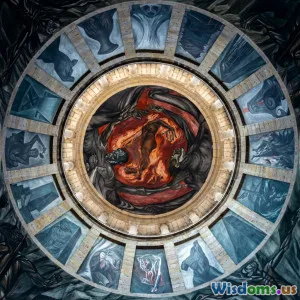
How Postmodernism Broke the Rules of Traditional Narrative
8 min read Explore how postmodernism transformed storytelling by defying traditional narrative structures and conventions. (0 Reviews)
How Postmodernism Broke the Rules of Traditional Narrative
When we think of stories, we often picture a beginning, middle, and end—a linear path guiding us through conflict, climax, and resolution. This classical narrative structure has dominated literature and storytelling for centuries. However, with the rise of postmodernism in the mid-20th century, these conventions started to unravel, challenging our assumptions about what stories are and how they should be told.
Introduction: The Birth of Narrative Disruption
Postmodernism emerged as a broad cultural, artistic, and intellectual movement after World War II, reacting against modernism's perceived rigidity and grand narratives. It questioned certainty, authoritative truths, and objective histories. This skepticism naturally extended to storytelling. Instead of neat, objective tales, postmodern narratives embraced ambiguity, fragmentation, and playfulness.
Renowned author Jorge Luis Borges once mused, “I have always imagined that paradise will be a kind of library.” Borges’s stories themselves epitomize postmodern narrative techniques—nonlinear timelines, recursive loops, and unreliable narrators—inviting readers to question reality and the nature of storytelling.
Today, we’ll explore exactly how postmodernism broke the rules of traditional narratives and the innovative storytelling methods birthed from this transformation.
Challenging the Linear: Nonlinear and Fragmented Structures
One of the most recognizable rule-breakers of postmodern narrative is the rejection of linearity. Traditional stories advance chronologically toward resolution. Postmodern works, in contrast, often present events out of order or in fragmented, seemingly chaotic sequences.
Fragmentation of Time and Structure
Thomas Pynchon’s Gravity’s Rainbow (1973) exemplifies narrative fragmentation. The novel’s sprawling cast and nonlinear plot defy easy summary, deliberately disorienting readers. Characters’ stories overlap, repeat, or diverge with no single, unified timeline, embodying postmodernism’s embrace of chaos and complexity.
By shattering temporal continuity, postmodern narratives encourage readers to actively participate in assembling meaning rather than passively absorbing it. This method reflects a more complex, less deterministic understanding of history and experience.
Hypertextuality and Intertextuality
Postmodern stories are often self-referential, drawing on and commenting upon other texts. This intertextuality blurs boundaries between narratives and invites a more playful reading experience.
For example, Mark Z. Danielewski’s novel House of Leaves (2000) is a labyrinth of nested stories, footnotes, and unexpected typographical designs, prompting readers to decode multiple narrative layers. Such works underscore postmodernism’s challenge to straightforward storytelling by making form and content inseparable.
The Death of the Author and Rise of Unreliable Narrators
The concept of “the death of the author,” popularized by literary theorist Roland Barthes, argues that stories don’t have a single, authoritative meaning dictated by the author. Instead, meaning arises through readers’ interpretations.
Unreliable Narrators
Postmodernism took this a step further by often adopting unreliable narrators to subvert reader expectations. These narrators cast doubt on the truthfulness of the story, forcing readers to question every detail.
Kurt Vonnegut’s Slaughterhouse-Five (1969) features Billy Pilgrim, a time-traveling, death-absorbing protagonist whose disjointed experiences defy conventional realism. The narrative style mirrors trauma’s fragmentary cognition and highlights the fuzziness of memory and truth.
Multiplicity of Voices
Further destabilizing traditional authority, postmodern novels frequently have multiple conflicting narrators or perspectives. Toni Morrison’s Beloved (1987), while containing more traditional emotional arcs, employs shifts in perspective and unreliable recollections, embedding trauma and history in layered narrative voices.
This multiplicity questions whether any single coherent story can capture complex realities, emphasizing subjectivity over objectivity.
Embracing Paradox and Play: Irony, Metafiction, and Pastiche
Postmodern storytelling is marked by self-awareness and irony, often breaking the fourth wall or drawing attention to fictionality.
Metafiction
Metafiction deliberately calls attention to the process of storytelling. In works like Italo Calvino’s If on a Winter’s Night a Traveler (1979), the narrative is about the act of reading itself, interweaving multiple interrupted stories. This recursive technique destabilizes traditional expectations, inviting readers to be conscious of narrative construction.
Irony and Parody
Irony runs deep in postmodern literature as a way to question established norms. Writers often parody or mimic styles and genres, blending them into pastiches that celebrate and critique simultaneously. David Foster Wallace’s essays and fiction navigate this terrain, combining encyclopedic knowledge, humor, and meta-commentary.
Mixing High and Low Culture
Postmodern narratives blur distinctions between “high” art and popular culture. For example, graphic novels like Art Spiegelman’s Maus (1980-91) tackle serious historical narratives through a comic book form, blending visual art and literature innovatively. This fusion disrupts traditional narrative hierarchies.
Real-World Insights: Postmodernism Beyond Literature
Postmodern narrative ruptures have influenced film, television, and digital media. Directors like Quentin Tarantino and David Lynch employ nonlinear storytelling, unreliable narrators, and self-referential themes.
In TV, series such as Westworld or Mr. Robot reflect postmodern sensibilities with layered realities and perspectives challenging viewers’ understanding of truth and character identity.
The rise of hypertext fiction and interactive narratives online further dismantles linearity, allowing users to navigate stories through multiple paths, embodying postmodern fragmentation in the digital age.
Conclusion: The Enduring Legacy of Postmodern Narrative
Postmodernism fundamentally reframed storytelling by breaking the classical rules of narrative coherence, linearity, and authority. It introduced fragmentation, metafiction, unreliable narrators, and playful, self-conscious techniques that invite readers and viewers to actively construct meaning.
While sometimes criticized for opacity or nihilism, postmodern narrative forms reflect a deeper questioning of reality, knowledge, and identity—concerns increasingly central to contemporary life.
For anyone seeking to understand the evolution of storytelling or grapple with the complexities of modern narratives, exploring postmodernism offers a rich, challenging, and rewarding experience that continues to shape art and culture.
References:
- Barthes, Roland. "The Death of the Author." In Image-Music-Text, 1967.
- Pynchon, Thomas. Gravity’s Rainbow, 1973.
- Vonnegut, Kurt. Slaughterhouse-Five, 1969.
- Calvino, Italo. If on a Winter’s Night a Traveler, 1979.
- Danielewski, Mark Z. House of Leaves, 2000.
- Morrison, Toni. Beloved, 1987.
- Spiegelman, Art. Maus, 1980-91.
These works and concepts illuminate how postmodernism fundamentally shifted how narratives function, inviting us all to become more attentive, critical, and imaginative readers and storytellers.
Rate the Post
User Reviews
Popular Posts



















